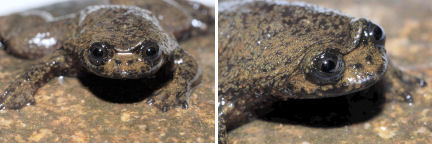Looks like a frog. Swims like a frog. But doesn’t croak. A flattened, brown, aquatic species from Borneo has just become the only frog shown to have no lungs.

The species, Barbourula kalimantanensis, is so rare that until last year only two specimens were known to science and no herpetologist had seen it alive, says David Bickford of the National University of Singapore.
“It’s one of the most famous frogs in Borneo,” says Bickford. No one wanted to slice the frogs up for dissection, so no one had noticed the absence of lungs.
But last year herpetologists on an expedition to a remote section of Borneo managed to collect more of the frogs. Bickford and the man who first named the species—Djoko Iskandar, now at the Bandung Institute of Technology in Indonesia—led the trek.
After traveling to waters near Nanga Pinoh where the original collector had first discovered the frog, and finding the area “completely trashed by all the illegal gold mining,” Bickford, Iskandar and the others traveled through difficult country in search of unspoiled waters.
In a fast mountain river, a 45-minute frog search turned Bickford’s lips blue and chilled the dexterity out of his hands. “I was getting hypothermia in the tropics,” he says. “The water is moving so fast it takes the heat out of your body.”
This water, it turns out, is ideal for a lungless frog. “They weren’t incredibly hard to catch, but they were incredibly slippery,” Bickford says.
The cold-water home holds more dissolved oxygen than warm water does, says Bickford. And the water current rushing along at 2 to 5 meters per second steadily renews the oxygen supply.
The frogs have flattened bodies, shaped more like a cookie than an apple, with plenty of surface area for gas exchange. So they probably get all the oxygen they need through their skin, the researchers will report online April 17 in Current Biology.
Bickford and Iskandar dissected several frogs on the spot and found no lungs. Iskandar immediately realized that they could be the first normally lungless frog. The researchers brought the specimens back to their labs for further research.
The Borneo frog’s closest living kin, evolutionarily, lives in the Philippines and does have lungs. That sister species’ conventional breathing apparatus supports the idea that the Borneo frog evolved from ancestors with lungs that were later lost in the highly aerated water, Bickford says. Lungs could even be a disadvantage in white water, making a frog more buoyant and easier for the current to sweep away.
Amphibian evolution exhibits more flexibility in breathing than seen in the histories of mammals, birds and reptiles. Those three groups all breathe with some form of lung, but amphibians have lost their lungs at least two other times in evolutionary history. Lungless salamanders show up in two families, including some 320 skin-breather species in the Plethodontid family widespread across the Americas. One South American species of caecilian, a wormy-looking amphibian, also lacks lungs.
Herpetologist Robert F. Inger of the Field Museum of Natural History in Chicago says he heard about the find soon after the expedition returned from Borneo. “I was astonished,” he says.
He has studied Borneo’s frogs for some 50 years, and he had examined the original specimen of the frog in the 1970s, when Iskandar shipped it to him on loan for consultation about how to classify it. The island is full of surprises, Inger says. This is far from the only frog in Borneo described from just a few specimens.
Seeing the destruction caused by the mining in the frog’s original habitat fueled Bickford’s concerns for Borneo’s amphibian diversity. The lungless frog, with its small known range, is listed as endangered by IUCN conservation monitors. Small-time gold-mining operations are turning previously fast, cold, frog-friendly rivers into wide, slow, muddy soup. Yet the people who run the operations have few other economic options. “It’s a classic problem you find in conservation,” Bickford says.






